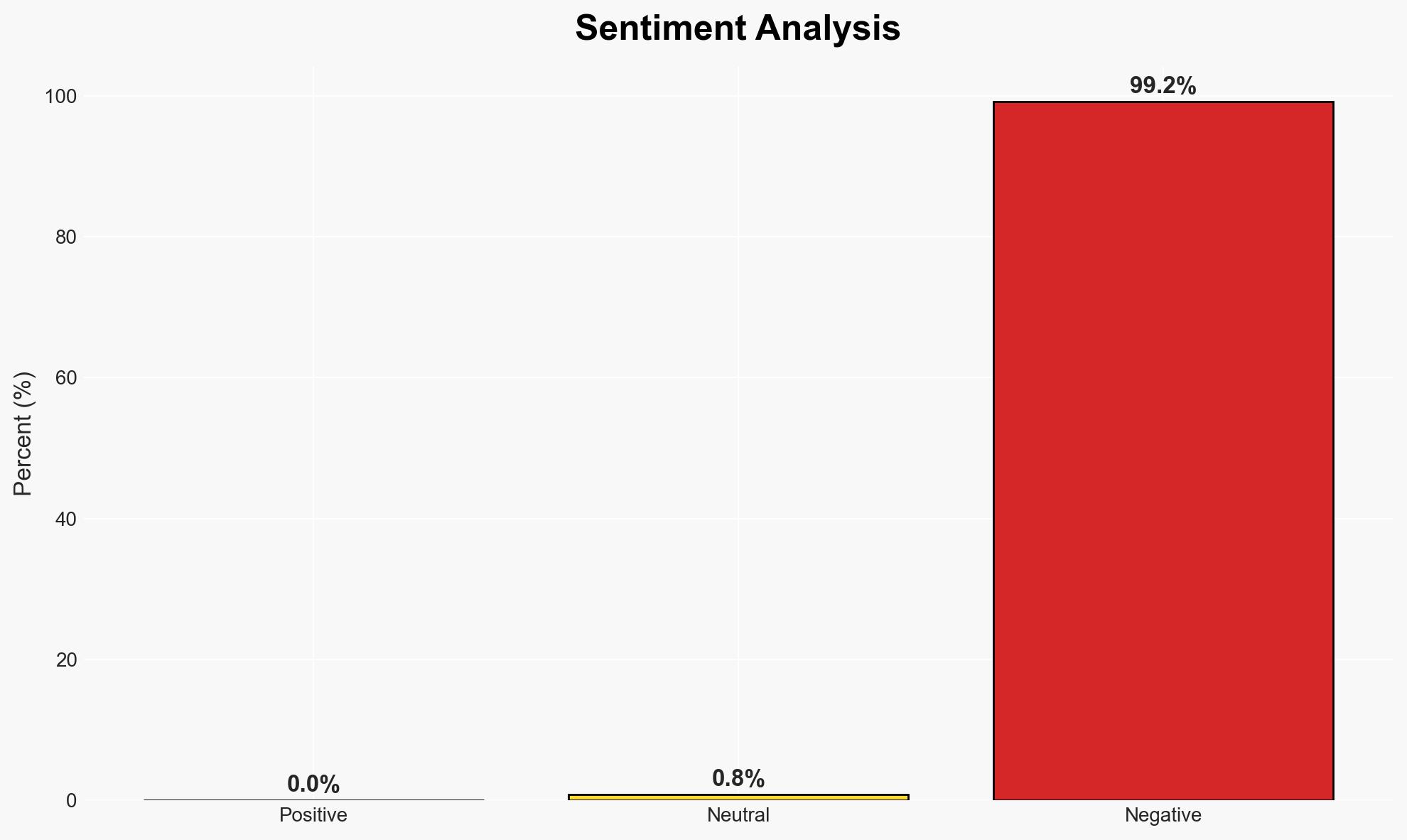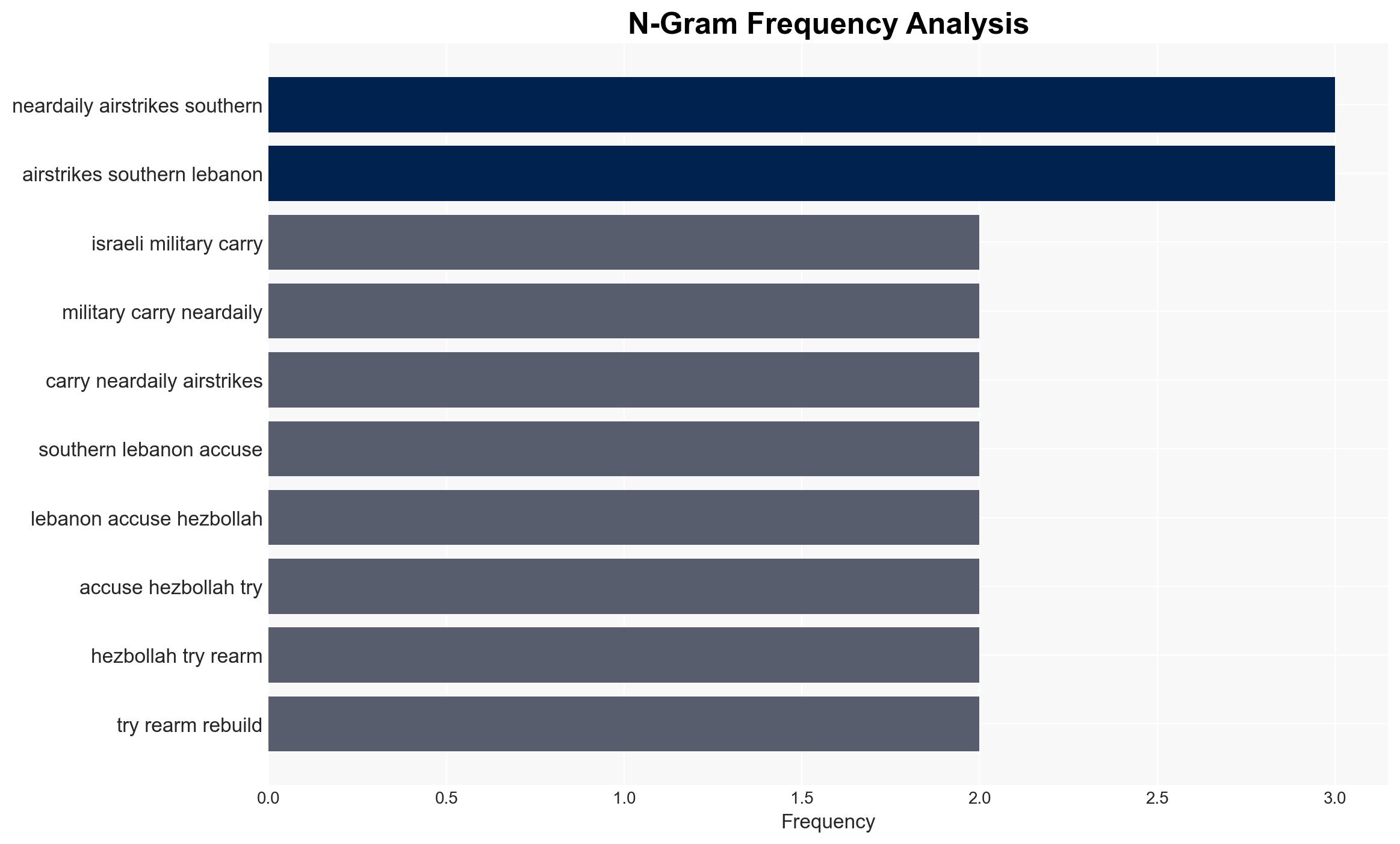Concerns Mount Over Potential Resurgence of Conflict One Year After Israel-Hezbollah Ceasefire
Published on: 2025-11-27
AI-powered OSINT brief from verified open sources. Automated NLP signal extraction with human verification. See our Methodology and Why WorldWideWatchers.
Intelligence Report: One year after Israel-Hezbollah ceasefire fears rise of a return to war
1. BLUF (Bottom Line Up Front)
The situation between Israel and Hezbollah remains tense, with ongoing violations of the ceasefire agreement by both parties. The most likely scenario is a gradual escalation of hostilities, potentially leading to renewed conflict, affecting regional stability and security. Overall confidence in this assessment is moderate, given the complexity of the geopolitical environment and the lack of complete information.
2. Competing Hypotheses
- Hypothesis A: Israel and Hezbollah will return to full-scale conflict due to continued ceasefire violations and military build-up. Supporting evidence includes near-daily airstrikes by Israel and Hezbollah’s attempts to rearm. However, the lack of decisive military engagements and ongoing diplomatic efforts are key uncertainties.
- Hypothesis B: Despite tensions, Israel and Hezbollah will avoid full-scale conflict, maintaining a fragile status quo. This is supported by the Lebanese government’s efforts to disarm Hezbollah and international diplomatic pressure. Contradicting evidence includes persistent military actions and accusations of ceasefire violations by both sides.
- Assessment: Hypothesis A is currently better supported due to the frequency of military engagements and the rhetoric from both sides indicating a willingness to escalate. Indicators such as increased diplomatic engagement or a reduction in military activities could shift this judgment.
3. Key Assumptions and Red Flags
- Assumptions: Both parties have the capability and intent to escalate; international actors will continue diplomatic interventions; Hezbollah retains significant influence in Lebanon.
- Information Gaps: Detailed intelligence on Hezbollah’s military capabilities and intentions; clarity on the effectiveness of Lebanese government disarmament efforts.
- Bias & Deception Risks: Potential bias in Israeli and Lebanese sources; risk of deception by both parties to manipulate international perceptions.
4. Implications and Strategic Risks
The ongoing tensions could lead to a broader regional conflict, impacting international relations and security dynamics. The situation may also exacerbate internal Lebanese instability and strain Israeli security resources.
- Political / Geopolitical: Potential for increased regional polarization and involvement of external powers, such as the U.S. and Iran.
- Security / Counter-Terrorism: Heightened threat of cross-border attacks and terrorism, affecting civilian safety and military readiness.
- Cyber / Information Space: Increased cyber operations and propaganda efforts by both sides to influence public opinion and international support.
- Economic / Social: Economic destabilization in Lebanon, potential refugee flows, and social unrest in affected areas.
5. Recommendations and Outlook
- Immediate Actions (0–30 days): Enhance intelligence collection on military movements; engage in diplomatic dialogues to de-escalate tensions; monitor cyber activities for disinformation campaigns.
- Medium-Term Posture (1–12 months): Strengthen regional alliances and partnerships; invest in defensive capabilities; support Lebanese government efforts to stabilize the region.
- Scenario Outlook:
- Best Case: Diplomatic resolution and reduction in hostilities, triggered by successful international mediation.
- Worst Case: Full-scale war, triggered by a significant military incident or political miscalculation.
- Most Likely: Continued low-intensity conflict with sporadic escalations, triggered by ongoing ceasefire violations.
6. Key Individuals and Entities
- Israeli Defense Minister Israel Katz
- Lebanese President Joseph Aoun
- Hezbollah leadership (not specifically named)
- Sarit Zehavi, Alma Research and Education Center
- Karim Emile Bitar, Sciences Po Paris
7. Thematic Tags
Structured Analytic Techniques Applied
- ACH 2.0: Reconstruct likely threat actor intentions via hypothesis testing and structured refutation.
- Indicators Development: Track radicalization signals and propaganda patterns to anticipate operational planning.
- Narrative Pattern Analysis: Analyze spread/adaptation of ideological narratives for recruitment/incitement signals.
Explore more:
Counter-Terrorism Briefs ·
Daily Summary ·
Support us





